Pure Monopoly 10 Copyright ©


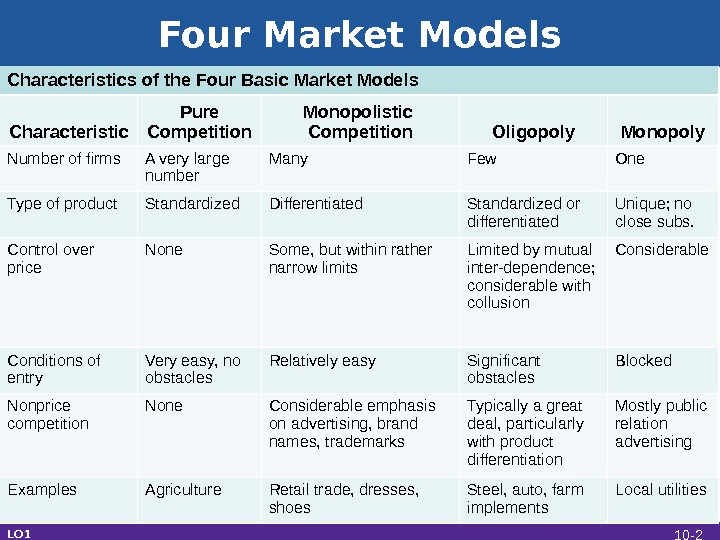



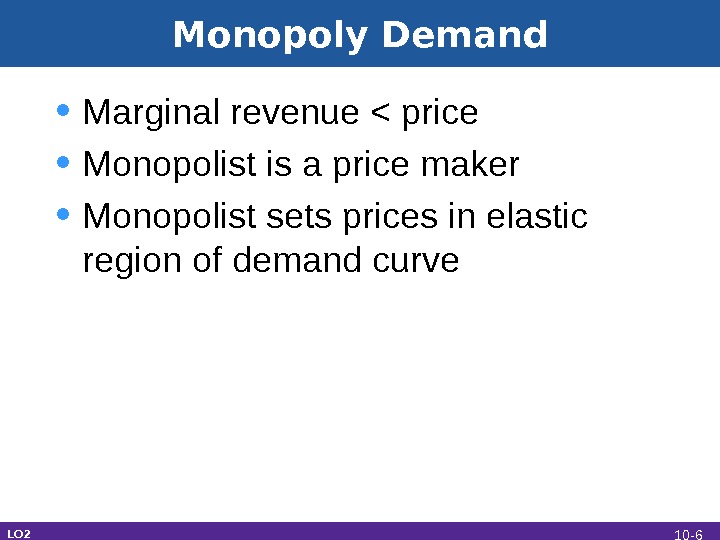
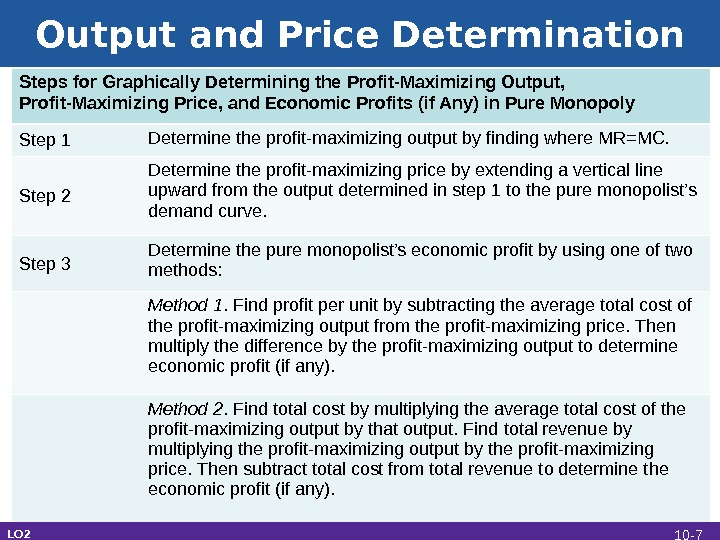

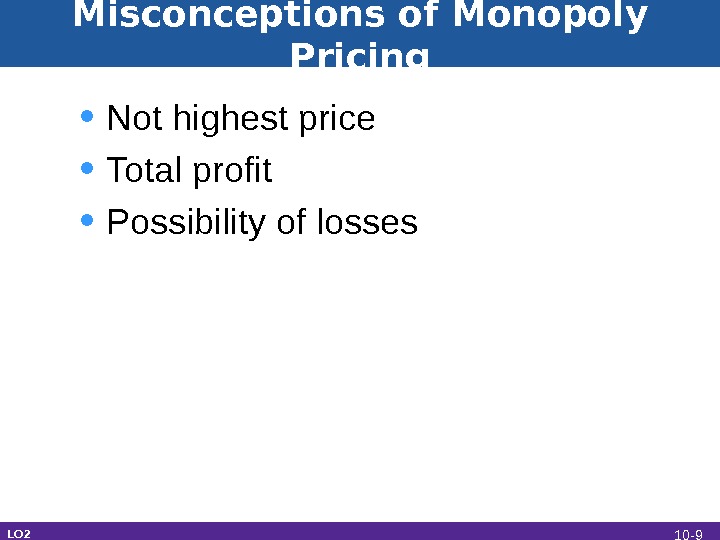


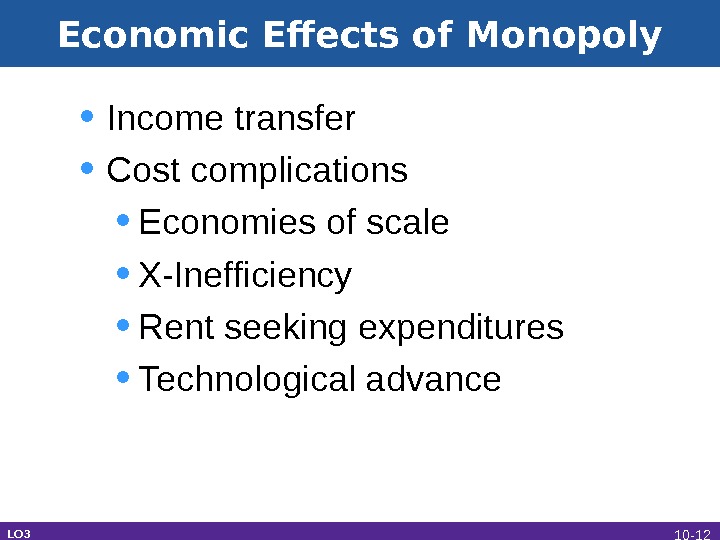
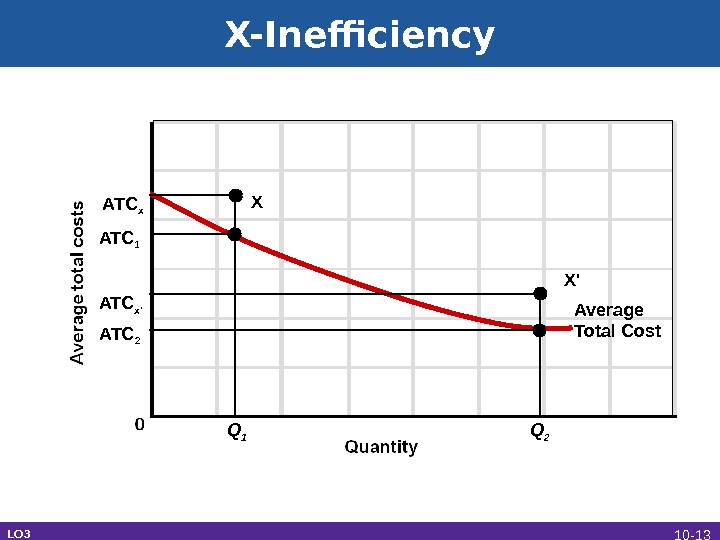
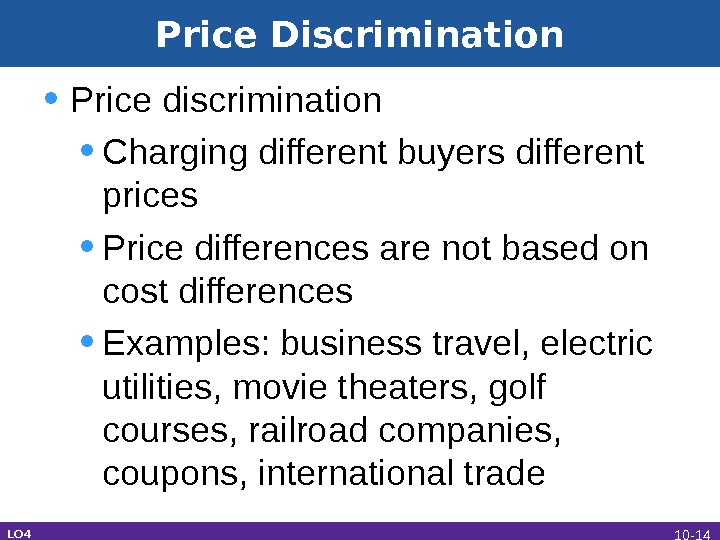



- Размер: 847.5 Кб
- Количество слайдов: 17
Описание презентации Pure Monopoly 10 Copyright © по слайдам
 Pure Monopoly 10 Copyright © 2012 by The Mc. Graw-Hill Companies, Inc. All rights reserved. Mc. Graw-Hill/Irwin
Pure Monopoly 10 Copyright © 2012 by The Mc. Graw-Hill Companies, Inc. All rights reserved. Mc. Graw-Hill/Irwin
 Four Market Models LO 1 Characteristics of the Four Basic Market Models Characteristic Pure Competition Monopolistic Competition Oligopoly Monopoly Number of firms A very large number Many Few One Type of product Standardized Differentiated Standardized or differentiated Unique; no close subs. Control over price None Some, but within rather narrow limits Limited by mutual inter-dependence; considerable with collusion Considerable Conditions of entry Very easy, no obstacles Relatively easy Significant obstacles Blocked Nonprice competition None Considerable emphasis on advertising, brand names, trademarks Typically a great deal, particularly with product differentiation Mostly public relation advertising Examples Agriculture Retail trade, dresses, shoes Steel, auto, farm implements Local utilities 10 —
Four Market Models LO 1 Characteristics of the Four Basic Market Models Characteristic Pure Competition Monopolistic Competition Oligopoly Monopoly Number of firms A very large number Many Few One Type of product Standardized Differentiated Standardized or differentiated Unique; no close subs. Control over price None Some, but within rather narrow limits Limited by mutual inter-dependence; considerable with collusion Considerable Conditions of entry Very easy, no obstacles Relatively easy Significant obstacles Blocked Nonprice competition None Considerable emphasis on advertising, brand names, trademarks Typically a great deal, particularly with product differentiation Mostly public relation advertising Examples Agriculture Retail trade, dresses, shoes Steel, auto, farm implements Local utilities 10 —
 An Introduction to Pure Monopoly • Single seller – a sole producer • No close substitutes – unique product • Price maker – control over price • Blocked entry – strong barriers to entry block potential competition • Non-price competition – mostly PR or advertising the product LO 1 Public utility companies • Natural Gas • Electric • Water Near monopolies • Intel • Wham-O Professional sports teams 10 —
An Introduction to Pure Monopoly • Single seller – a sole producer • No close substitutes – unique product • Price maker – control over price • Blocked entry – strong barriers to entry block potential competition • Non-price competition – mostly PR or advertising the product LO 1 Public utility companies • Natural Gas • Electric • Water Near monopolies • Intel • Wham-O Professional sports teams 10 —
 Barriers to Entry • Barrier to entry: a factor that keeps firms from entering an industry • Economies of scale • Legal barriers: patents and licenses • Ownership of essential resources • Pricing LO 1 10 —
Barriers to Entry • Barrier to entry: a factor that keeps firms from entering an industry • Economies of scale • Legal barriers: patents and licenses • Ownership of essential resources • Pricing LO 1 10 —
 Monopoly Demand • The pure monopolist is the industry • Demand curve is the market demand curve • Downsloping demand curve • Marginal revenue is less than price LO 1 10 —
Monopoly Demand • The pure monopolist is the industry • Demand curve is the market demand curve • Downsloping demand curve • Marginal revenue is less than price LO 1 10 —
 Monopoly Demand • Marginal revenue < price • Monopolist is a price maker • Monopolist sets prices in elastic region of demand curve LO 2 10 —
Monopoly Demand • Marginal revenue < price • Monopolist is a price maker • Monopolist sets prices in elastic region of demand curve LO 2 10 —
 Output and Price Determination LO 2 Steps for Graphically Determining the Profit-Maximizing Output, Profit-Maximizing Price, and Economic Profits (if Any) in Pure Monopoly Step 1 Determine the profit-maximizing output by finding where MR=MC. Step 2 Determine the profit-maximizing price by extending a vertical line upward from the output determined in step 1 to the pure monopolist’s demand curve. Step 3 Determine the pure monopolist’s economic profit by using one of two methods: Method 1. Find profit per unit by subtracting the average total cost of the profit-maximizing output from the profit-maximizing price. Then multiply the difference by the profit-maximizing output to determine economic profit (if any). Method 2. Find total cost by multiplying the average total cost of the profit-maximizing output by that output. Find total revenue by multiplying the profit-maximizing output by the profit-maximizing price. Then subtract total cost from total revenue to determine the economic profit (if any). 10 —
Output and Price Determination LO 2 Steps for Graphically Determining the Profit-Maximizing Output, Profit-Maximizing Price, and Economic Profits (if Any) in Pure Monopoly Step 1 Determine the profit-maximizing output by finding where MR=MC. Step 2 Determine the profit-maximizing price by extending a vertical line upward from the output determined in step 1 to the pure monopolist’s demand curve. Step 3 Determine the pure monopolist’s economic profit by using one of two methods: Method 1. Find profit per unit by subtracting the average total cost of the profit-maximizing output from the profit-maximizing price. Then multiply the difference by the profit-maximizing output to determine economic profit (if any). Method 2. Find total cost by multiplying the average total cost of the profit-maximizing output by that output. Find total revenue by multiplying the profit-maximizing output by the profit-maximizing price. Then subtract total cost from total revenue to determine the economic profit (if any). 10 —
 $200 175 150 125 25100 75 50 P rice, C o sts, an d R even u e 1 2 3 4 5 6 7 8 9 10 Quantity. Output and Price Determination LO 2 0 D MR ATCMC MR=MCA =$94 Economic Profit. P m =$122 10 —
$200 175 150 125 25100 75 50 P rice, C o sts, an d R even u e 1 2 3 4 5 6 7 8 9 10 Quantity. Output and Price Determination LO 2 0 D MR ATCMC MR=MCA =$94 Economic Profit. P m =$122 10 —
 Misconceptions of Monopoly Pricing • Not highest price • Total profit • Possibility of losses LO 2 10 —
Misconceptions of Monopoly Pricing • Not highest price • Total profit • Possibility of losses LO 2 10 —
 Misconceptions of Monopoly Pricing LO 2 0 D MR ATCMC MR=MCLoss AVCP m Q m. VA 10 —
Misconceptions of Monopoly Pricing LO 2 0 D MR ATCMC MR=MCLoss AVCP m Q m. VA 10 —
 Economic Effects of Monopoly LO 3 (a) Purely Competitive Market (b) Pure Monopoly. D DS= MC MC P=MC= Minimum ATC MRP c Q c P c. P m Q c. Q m. Pure competition is efficient Monopoly is inefficient a b cd 10 —
Economic Effects of Monopoly LO 3 (a) Purely Competitive Market (b) Pure Monopoly. D DS= MC MC P=MC= Minimum ATC MRP c Q c P c. P m Q c. Q m. Pure competition is efficient Monopoly is inefficient a b cd 10 —
 Economic Effects of Monopoly • Income transfer • Cost complications • Economies of scale • X-Inefficiency • Rent seeking expenditures • Technological advance LO 3 10 —
Economic Effects of Monopoly • Income transfer • Cost complications • Economies of scale • X-Inefficiency • Rent seeking expenditures • Technological advance LO 3 10 —
 X-Inefficiency LO 3 ATC 2 ATC 1 ATC x Q 1 Q 2 Average Total Cost. X X’ ATC x’ 10 —
X-Inefficiency LO 3 ATC 2 ATC 1 ATC x Q 1 Q 2 Average Total Cost. X X’ ATC x’ 10 —
 Price Discrimination • Price discrimination • Charging different buyers different prices • Price differences are not based on cost differences • Examples: business travel, electric utilities, movie theaters, golf courses, railroad companies, coupons, international trade LO 4 Price Discrimination 10 —
Price Discrimination • Price discrimination • Charging different buyers different prices • Price differences are not based on cost differences • Examples: business travel, electric utilities, movie theaters, golf courses, railroad companies, coupons, international trade LO 4 Price Discrimination 10 —
 • Conditions for success: • Monopoly power • Market segregation • No resale Price Discrimination LO 4 10 —
• Conditions for success: • Monopoly power • Market segregation • No resale Price Discrimination LO 4 10 —
 Regulated Monopoly • Natural monopolies • Socially optimal price • Set price = marginal cost • Fair return price • Set price = ATC LO 5 10 —
Regulated Monopoly • Natural monopolies • Socially optimal price • Set price = marginal cost • Fair return price • Set price = ATC LO 5 10 —
 Regulated Monopoly LO 5 Monopoly Price Fair-Return Price Socially Optimal Price P r Drf ba P f. P m Q f Q r. MR MCATC 10 —
Regulated Monopoly LO 5 Monopoly Price Fair-Return Price Socially Optimal Price P r Drf ba P f. P m Q f Q r. MR MCATC 10 —

